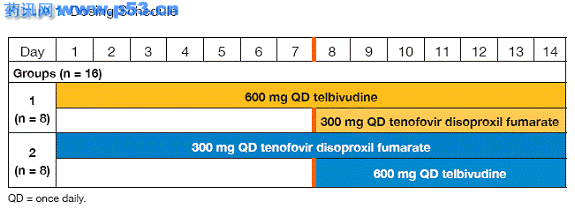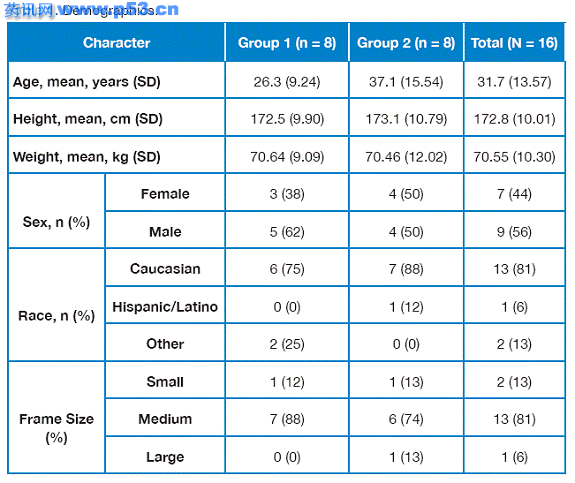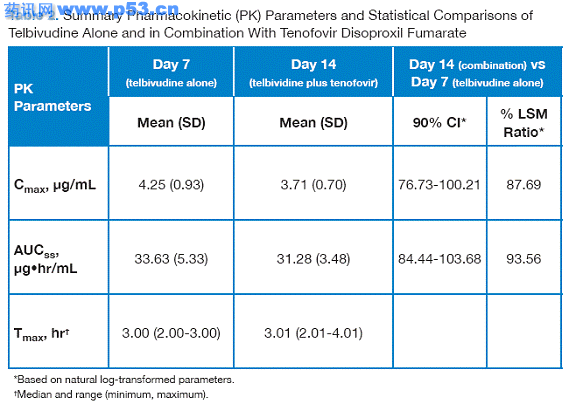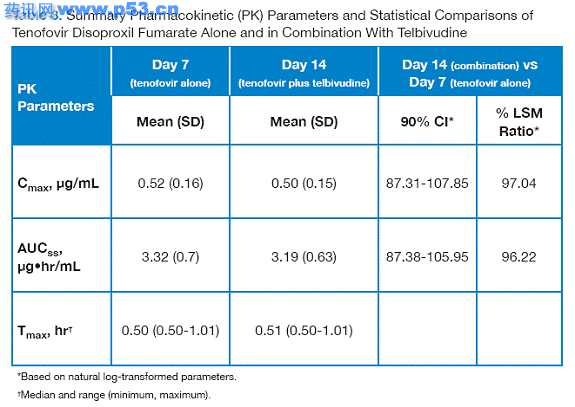Background
Telbivudine, an L-nucleoside with potent, specific activity against the hepatitis B virus,1 has been widely approved for the treatment of compensated chronic hepatitis B (CHB). In a large, 2-year, international, phase III trial (GLOBE), telbivudine showed significantly greater efficacy vs lamivudine on all direct measures of antiviral efficacy and on several key clinical measures.2-4 Advances in the management of CHB aim to improve clinical outcomes in hepatitis B disease and currently involve combining or alternating complementary antiviral agents.5 In this report, we evaluate the pharmacokinetic (PK) interactions between telbivudine and tenofovir disoproxil fumarate, an anti-HIV nucleotide with potent anti-HBV activity. The objectives of this study were first to assess possible steady-state pharmacokinetic drug-drug interactions between telbivudine and tenofovir disoproxil fumarate (‘tenofovir’) and then to evaluate the safety and tolerability of telbivudine following administration in healthy subjects, both alone and in combination with tenofovir. The primary endpoint of this study was the natural logarithmic (ln)-transformed pharmacokinetic measures of plasma drug exposure.
Methods
Dosing Schedules
In this phase I, open-label study, healthy male and female volunteers (n = 16) between 19 and 65 years of age were randomized (1:1) to two parallel groups (Figure 1). Group 1 received telbivudine 600 mg/day for seven consecutive days (days 1–7), followed by telbivudine 600 mg/day plus tenofovir 300 mg/day for an additional seven days (days8–14). Group 2 received tenofovir 300 mg/day on days 1–7, followed by tenofovir plus telbivudine 600 mg/day on days 8–14. All medications were administered on an empty stomach.

Pharmacokinetic Procedures
Blood Sampling and Bioanalysis
● Steady-state PK of the study drugs alone and in combination was evaluated on days 7 and 14, respectively.
● Intensive blood sampling was performed over the dosing interval (τ = 24 hours) on day 7 for telbivudine or tenofovir disoproxil fumarate as single agents and on day 14 for combination. Blood samples were drawn prior to and following dosing at the following time-points: 0 (pre-dose), 0.5, 1, 2, 3, 4, 8, 12, 16, 20, and 24 hours post-dose.
● Plasma concentrations of telbivudine and tenofovir were determined by validated liquid chromatography-tandem mass spectrometry (LC/MS/MS) methods with a limit of quantification of 10.0 and 5.0 ng/mL, respectively.
Pharmacokinetics Analysis
● The following principal PK parameters for telbivudine and tenofovir at steady state were obtained using noncompartmental analysis from the concentration-time profiles: area under the curve (AUCss), peak plasma concentration (Cmax), and time to reach Cmax (Tmax).
Statistical Analysis
● PK parameters were summarized by treatment group in each study using descriptive statistics.
● A parametric (normal-theory) mixed linear model was applied to the natural logarithmic transformation of AUCss and Cmax. Results for AUCss and Cmax were reported as 90% confidence intervals (CI) for the ratio of the geometric least-squares means (LSM) of the PK measures with and without the second drug in each group. It was concluded that no statistically significant drug interaction existed if the 90% CI for the ratio of LSM were within the range of 70%-143% for AUCss and Cmax.
Safety Analysis
● Safety assessments included clinical history, physical examination, laboratory evaluations (chemistry, hematology, urinalysis), and vital signs (blood pressure and pulse). Adverse event (AE) and serious adverse event (SAE) assessments were classified using the MedDRA (version 6.1) and recorded according to their severity as mild (grade 1), moderate (grade 2), severe (grade 3), or life-threatening (grade 4) and whether or not they were reasonably or possibly related to the study drug. All subjects who received at least one dose of the study drugs were included in the safety analysis.
● Descriptive statistics (number of observations, number of missing observations, mean or median if relevant, standard deviation of standard error of the mean, minimum and maximum values, where applicable) of safety parameters were reported for each group.
Results
Subject Demographics
Baseline characteristics are summarized in Table 1. Subjects were predominantly Cau-casian and had a medium-sized frame.

Pharmacokinetics
All subjects completed the study according to protocol and were included in the telbivudine or tenofovir PK analysis and safety analysis.
Telbivudine
For the telbivudine Cmax, the 90% CI of the ratio of the geometric LSMs of telbivudine in combination with tenofovir vs telbivudine alone fell within the interval for non-significance, 70%-143%. The AUCss of telbivudine plasma exposure was also not significantly affected by concurrent tenofovir with geometric LSM ratio within 70%-143% (Table 2). The median Tmax of telbivudine between the two treatments were similar.

The mean steady-state plasma telbivudine concentration-time profiles were similar for telbivudine administered with tenofovir (day 14) and telbivudine administered alone(day 7) (Figure 2).
Figure 2. Mean (SD) Plasma Concentration-Time Curves of Telbivudine Alone (Day 7) and in Combination With Tenofovir Disoproxil Fumarate (Day 14)

Tenofovir
Plasma PK parameters, Cmax and AUCss for tenofovir alone and in combination with telbivudine, had similar geometric LSMs with associated 90% CI falling within the 90% CI nonsignificance interval of 70%-143%. Likewise, the median values for Tmax were comparable (Table 3).

As observed in Figure 3, mean plasma tenofovir concentration-time profiles were comparable regardless of whether tenofovir disoproxil fumarate was administered with telbivudine (day 14) or administered alone (day 7).
Figure 3. Mean (SD) Plasma Concentration Versus Time Curves of Tenofovir Alone (Day 7) and in Combination With Telbivudine (Day 14)

Safety Evaluation
● No serious adverse events occurred during the study.
● The number of adverse events reported for telbivudine alone, tenofovir alone and telbivudine plus tenofovir were very similar and were generally mild in nature. No subject experienced either a life-threatening or severe adverse event.
● A total of 11 adverse events were reported among six out of eight subjects receiving telbivudine alone. Fatigue was the most frequently experienced adverse event (n=2, 25%). One instance of dizziness and one of joint pain were considered moderate in severity.
● A total of nine adverse events were reported among four out of eight subjects on tenofovir alone. Acne and nausea were the most frequently reported adverse events with 2 occurrences each. One incidence of nausea was judged to be moderate in severity.
● A total of thirteen adverse events were reported among six out of sixteen subjects receiving telbivudine plus tenofovir. Headache was the most frequently reported event (n=6, 46%). Two instances of headache were classified as moderate in severity.
Discussion and Conclusions
● No statistically significant interaction was observed between oral telbivudine and tenofovir disoproxil fumarate with respect to their steady-state PK. The 90% CI of the ratio of the geometric LSMs for Cmax and AUCs for both drugs fell within the predefined no-significance range of 70%-143%.
● Telbivudine alone or in combination with tenofovir disoproxil fumarate appears to be well tolerated in healthy subjects.
● The absence of PK drug-drug interaction in healthy subjects between telbivudine and tenofovir disoproxil fumarate provides pharmacologic support for coadministration of telbivudine and tenofovir if clinically indicated.
Disclosures
X.J. Zhou, K. Pietropaolo, and M. Becker are employees of Idenix Pharmaceuticals.
J. Ke is an employee of Novartis Pharmaceuticals Corp.
N. Brown is a former employee of Idenix Pharmaceuticals.
References
1. Standring DN, Bridges EG, Placidi L, et al. Antiviral β-L-nucleosides specific for the hepatitis B virus infection. Antivir Chem Chemother. 2001;12(suppl 1):119-129.
2. Lai C-L, Gane E, Liaw Y-F, et al. Telbivudine (LdT) vs. lamivudine for chronic hepatitis B: first-year results from the international phase III GLOBE trial. Hepatology. 2005;42(4 suppl 1):748A. Abstract LB01.
3. Lai C-L, Gane E, Liaw Y-F, et al. Two-year results from the GLOBE trial in patients with hepatitis B: greater clinical and antiviral efficacy for telbivudine (LdT) vs. lamivudine. Hepatology. 2006;44(4 suppl 1):222A. Abstract 91.
4. Di Bisceglie AM, Lai C-L, Gane E, et al. Telbivudine GLOBE trial: maximal early HBV suppression is predictive of optimal two-year efficacy in nucleoside-treated hepatitis B patients. Hepatology. 2006;44(4 suppl 1):230A. Abstract 112.
5. Zhou XJ, Fielman BA, Lloyd DM, et al. Pharmacokinetics of telbivudine in healthy subjects and absence of drug interaction with lamivudine or adefovir dipivoxil. Antimicrob Agents Chemother. 2006;50(7):2309-2315.
Presented at: Digestive Disease Week; May 19 - 24, 2007. Washington DC, USA.

